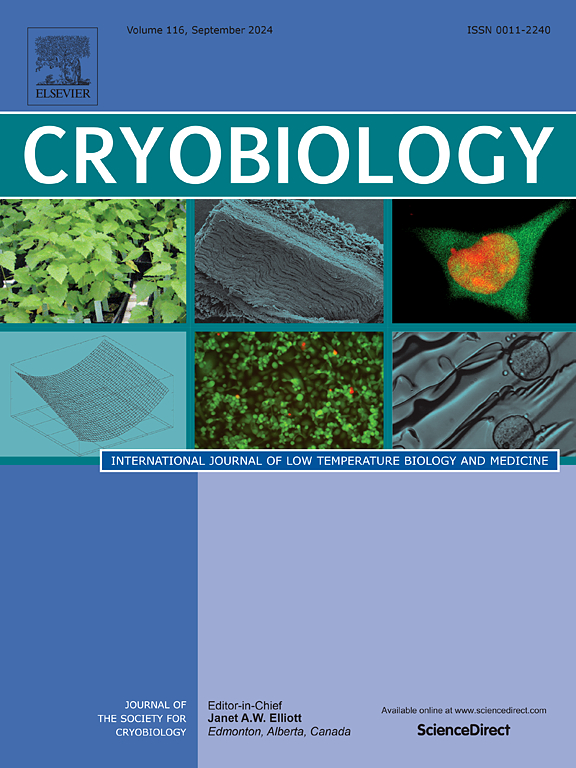Modeling and typical cases analyze at the cell-scale of transmembrane transport and intracellular crystallization and recrystallization during the freeze-thaw process
IF 2.1
3区 生物学
Q2 BIOLOGY
引用次数: 0
Abstract
Mechanical and solute damage caused by ice crystals during the freeze-thaw process of biological samples in cryopreservation are principal determinants of their activity. In this study, a numerical model is constructed by comprehensively considering the phenomenon of crystallization during cooling, recrystallization during rewarming, and the transmembrane transport of water and cryoprotective agent (CPA). The computational findings of the model demonstrate that higher cooling rates result in an increased volume of intracellular crystallization, with a correspondingly elevated intracellular nucleation temperature. By integrating the trend of CPA concentration variation during the cooling process, it is determined that the rates of 0.5 °C·min−1 and 1 °C·min−1 inflict minimal harm to mouse oocytes. During the rewarming process, the rate influences the intracellular ice volume, specifically the higher the rate of rewarming the smaller the increase in intracellular ice volume, and it is recommended that a high-power pulse be added before recrystallization to reduce the effects of recrystallization in practical applications. The pick-and-place operation of the cryopreservation vials can lead to recrystallization, and based on the calculations, it is recommended that the cryopreservation temperature should be lower than −160 °C and the operation time should be controlled within 90 s. The parameter scanning showed that a cooling rate of 0.4–1.8 °C·min−1 and an initial DMSO concentration of 0.1–0.3 M are more favorable for the efficient recovery in the water bath of mouse oocytes. The model constructed in this study can provide valuable numerical guidance for practical cryopreservation protocols of biological specimens.
在细胞尺度上对冻融过程中的跨膜运输、胞内结晶和再结晶进行建模和典型案例分析。
生物样品在冷冻保存过程中,冰晶在冻融过程中造成的机械损伤和溶质损伤是其活性的主要决定因素。本研究通过综合考虑冷却过程中的结晶现象、回温过程中的再结晶现象以及水和低温保护剂(CPA)的跨膜运输,构建了一个数值模型。模型的计算结果表明,较高的冷却速率会导致细胞内结晶体积增大,细胞内成核温度相应升高。通过综合冷却过程中 CPA 浓度的变化趋势,可以确定 0.5 °C-min-1 和 1 °C-min-1 的冷却速率对小鼠卵母细胞的伤害最小。在回温过程中,速率会影响细胞内的冰体积,具体来说,回温速率越高,细胞内冰体积的增加就越小,建议在重结晶之前加入一个高功率脉冲,以减少重结晶在实际应用中的影响。参数扫描结果表明,0.4∼1.8 °C-min-1 的冷却速率和 0.1∼0.3 M 的初始 DMSO 浓度更有利于小鼠卵母细胞在水浴中的高效复苏。本研究建立的模型可为生物样本的实际低温保存方案提供有价值的数值指导。
本文章由计算机程序翻译,如有差异,请以英文原文为准。
求助全文
约1分钟内获得全文
求助全文
来源期刊

Cryobiology
生物-生理学
CiteScore
5.40
自引率
7.40%
发文量
71
审稿时长
56 days
期刊介绍:
Cryobiology: International Journal of Low Temperature Biology and Medicine publishes research articles on all aspects of low temperature biology and medicine.
Research Areas include:
• Cryoprotective additives and their pharmacological actions
• Cryosurgery
• Freeze-drying
• Freezing
• Frost hardiness in plants
• Hibernation
• Hypothermia
• Medical applications of reduced temperature
• Perfusion of organs
• All pertinent methodologies
Cryobiology is the official journal of the Society for Cryobiology.
 求助内容:
求助内容: 应助结果提醒方式:
应助结果提醒方式:


